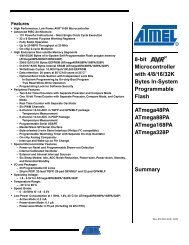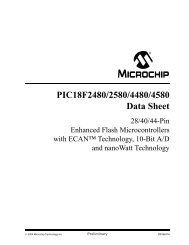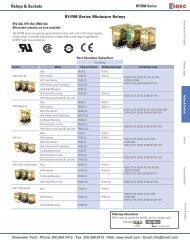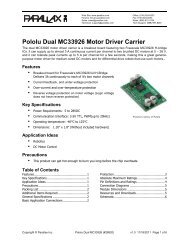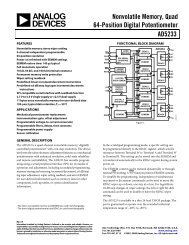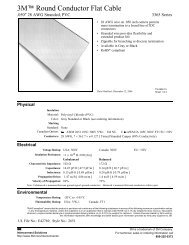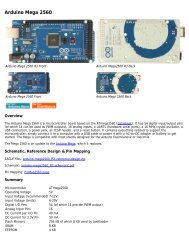FLEX 10KE Embedded Programmable Logic Device Data Sheet
FLEX 10KE Embedded Programmable Logic Device Data Sheet
FLEX 10KE Embedded Programmable Logic Device Data Sheet
Create successful ePaper yourself
Turn your PDF publications into a flip-book with our unique Google optimized e-Paper software.
<strong>FLEX</strong> <strong>10KE</strong> <strong>Embedded</strong> <strong>Programmable</strong> <strong>Logic</strong> <strong>Device</strong>s <strong>Data</strong> <strong>Sheet</strong><br />
Functional<br />
Description<br />
Each <strong>FLEX</strong> <strong>10KE</strong> device contains an enhanced embedded array to<br />
implement memory and specialized logic functions, and a logic array to<br />
implement general logic.<br />
The embedded array consists of a series of EABs. When implementing<br />
memory functions, each EAB provides 4,096 bits, which can be used to<br />
create RAM, ROM, dual-port RAM, or first-in first-out (FIFO) functions.<br />
When implementing logic, each EAB can contribute 100 to 600 gates<br />
towards complex logic functions, such as multipliers, microcontrollers,<br />
state machines, and DSP functions. EABs can be used independently, or<br />
multiple EABs can be combined to implement larger functions.<br />
The logic array consists of logic array blocks (LABs). Each LAB contains<br />
eight LEs and a local interconnect. An LE consists of a four-input look-up<br />
table (LUT), a programmable flipflop, and dedicated signal paths for carry<br />
and cascade functions. The eight LEs can be used to create medium-sized<br />
blocks of logic—such as 8-bit counters, address decoders, or state<br />
machines—or combined across LABs to create larger logic blocks. Each<br />
LAB represents about 96 usable gates of logic.<br />
Signal interconnections within <strong>FLEX</strong> <strong>10KE</strong> devices (as well as to and from<br />
device pins) are provided by the FastTrack Interconnect routing structure,<br />
which is a series of fast, continuous row and column channels that run the<br />
entire length and width of the device.<br />
Each I/O pin is fed by an I/O element (IOE) located at the end of each row<br />
and column of the FastTrack Interconnect routing structure. Each IOE<br />
contains a bidirectional I/O buffer and a flipflop that can be used as either<br />
an output or input register to feed input, output, or bidirectional signals.<br />
When used with a dedicated clock pin, these registers provide exceptional<br />
performance. As inputs, they provide setup times as low as 0.9 ns and<br />
hold times of 0 ns. As outputs, these registers provide clock-to-output<br />
times as low as 3.0 ns. IOEs provide a variety of features, such as JTAG<br />
BST support, slew-rate control, tri-state buffers, and open-drain outputs.<br />
8 Altera Corporation



